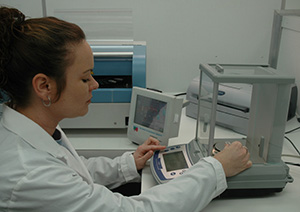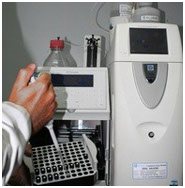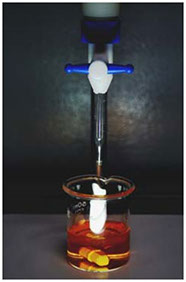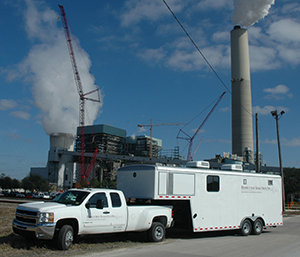
Gravimetric Analysis
HPLC/Ion Chromatography
Wet Chemistry
On-Site Analysis

Our state-of-the-art, environmentally controlled gravimetric laboratory is designed for one purpose — to achieve the highest quality gravimetric weights of small particulate matter.
We commonly perform gravimetric analyses for EPA methods 5, 17, 201A, 202, 315, cascade impacter particle sizing, hi-volumetric particulate and a variety of state regulated air methods.
Experience
Our experience in gravimetrics analysis for the air testing industry speaks for itself. When Air Control Techniques, Inc. developed the methodology that would eventually become the current EPA Method 202 they asked Resolution Analytics to perform their laboratory analysis. To this day we still provide all their gravimetric analysis!
We currently provide high quality gravimetric analysis for EPA methods 5, 17, 201A, 202, 315 and a variety of state regulated air methods.
Teflon Containers and Static Removal Control
From start to finish we use nothing but the latest technology to ensure accurate results. All weights are taken in lightweight, inert Teflon containers that marginalize container weight. Prior to weighing, static discharge (which makes accurate weighing nearly impossible), is first removed from the container by passing it through an air ionization gate.
Analytical Balances
Our analytical balances are designed to produce the greatest accuracy and reproducibility at the low weight spectrum (1.0 milligram to 100 grams).This is the most common weight range for air test samples. Our balances are each linked to our gravimetric computer, with weights being transmitted to the data file by digital uplink. This ensures that weights are never incorrectly recorded by manual error. Archived weights for sample containers are also linked to data spreadsheets, further ensuring gravimetric analytical integrity.
Reduce Your Hazmat Shipping Expense
Evaporate your solvent rinses (acetone probe washes, hexane impinger rinses etc.) on-site prior to shipment, and we’ll re-suspend your samples in our laboratory — saving your company hazmat shipping costs!
NEW!
Presentation given by Bruce Nemet, president of Resolution Analytics, at the Air Quality Measurement Methods and Technology Conference on April 25th, 2012:
Problems and Inconsistencies and Their Potential Solutions for Sampling and Analysis of EPA Method 202 Condensible PM Samples.


Ion Chromatography
Our ion chromatographs, both suppressed and non-suppressed, are configured and quality assured specifically for air testing methods. IC analysis is the foundation of our business, and with 25 years experience in performing ion chromatography analyses we can typically resolve problematic samples very quickly.
Resolution Analytics is one of the industry’s most experienced labs in the analysis of EPA Method 26/26A and CTM-027 field samples for hydrogen halides/halogens and ammonia, respectively. In fact it was Resolution that provided much of the analysis in the development of EPA’s CTM-027 for ammonia.
High Performance Liquid Chromatography: HPLC
HPLC, or High Performance Liquid Chromatography, is an advanced instrumental technique capable of separating (or speciating) a wide variety of chemical compounds. It is estimated that approximately 70% of all known compounds can be analyzed by HPLC.
After separation the analytes of choice are typically detected by UV spectrophotometry.
HPLC instrumentation is one of the best methods for the determination of organic compounds. It gives us the ability to provide our clients with several important air-method applications, including phenol, cresol, aldehydes, ketones, nicotine, organic acids, and polyaromatic hydrocarbons.
These instruments are rigorously maintained and audited to ensure consistent and accurate results. And whether your project is routine or experimental, our experience in using HPLC technology specifically for the air testing industry has enabled us to overcome many matrix issues such as low level concentrations, unusual methodology, complex matrices and difficult analytes. We can even develop new methods for analytes that are not currently promulgated for testing. Ask us about our method development options.

There are a number of test procedures for which advanced instrumentation is simply impractical and unnecessary. These traditional wet chemistry methods are still utilized for air testing. Our traditional wet chemistry services include spectrophotometric, titrimetric, and a variety of extraction procedures.
These analyses fulfill requirements for several specific EPA, NIOSH and NCASI air test methods, including EPA 6/8 for sulfates and EPA 323 for formaldehyde. Analytes including ammonia, sulfates, formaldehyde, and phenol can be determined using these fast yet reliable procedures.
SO2/ SO3 (EPA Method 6/8)
EPA Method 8 (determination of sulfuric acid mist and sulfur dioxide from stationary sources) is being utilized for a broad variety of stationary sources- sometimes even beyond the scope of its original intent. As a result, an increasing number of sources are tested which can impart significant levels of matrix effects to these field samples, particularly ammonia from power generation facilities utilizing ammonia injection technology.
To deal with matrix interferences, we have developed a number of interference reduction procedures in the analytical preparation of these samples. As further confirmation (or as a primary test method in many cases), we will typically run two or more samples by ion chromatography, particularly if a high level of interference is suspected.
Formaldehyde (EPA Method 323)
EPA Method 323 is a fast, rugged and reliable procedure for the sampling and analysis of formaldehyde in gas streams in which formaldehyde is the only known short-chain aldehydic species to exist. Although the EPA had decided to remove promulgation for this method in 2010, RAI was successful in getting it reinstated by the EPA in Subpart ZZZZ as part of RICE NESHAP in a side-by-side comparison with FTIR results in a field study performed in Wyoming.
We continue to provide this analytical service today as a quick and reliable test for formaldehyde primarily for our clients testing natural gas generators.

All of our currently-offered analytical services are now available for on-site analysis.
Call 919-346-5740 or email today for our on-site service pricing and availability.
2481 Reliance Avenue • Apex, North Carolina 27539 • 919-346-5740 • CONTACT
copyright © 2015-2023 Resolution Analytics, all rights reserved